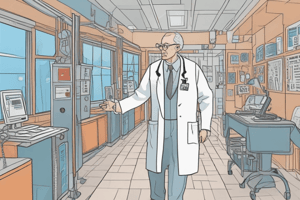Podcast
Questions and Answers
What are the three main categories of errors or active failures, as outlined in the document?
What are the three main categories of errors or active failures, as outlined in the document?
The three main categories of errors or active failures are slips and lapses, mistakes, and violations.
Describe the difference between a slip/lapse and a mistake.
Describe the difference between a slip/lapse and a mistake.
Slips and lapses are errors of action, where the individual knows what they intend to do but their action doesn't match, often due to attentional slips or memory lapses. Mistakes, on the other hand, are errors of knowledge or planning, where the action is carried out as intended but fails to achieve the desired outcome due to a wrong diagnosis or flawed plan.
What is a violation in the context of medical errors?
What is a violation in the context of medical errors?
A violation is an intentional deviation from protocols, standards, safe operating procedures, or other rules. This could include actions like not using proper aseptic techniques or disregarding established guidelines.
What are the primary goals of Root Cause Analysis (RCA)?
What are the primary goals of Root Cause Analysis (RCA)?
Provide three examples of preventable adverse events mentioned in the document.
Provide three examples of preventable adverse events mentioned in the document.
What are some of the key factors that contribute to variations in healthcare quality and outcomes across different regions or providers?
What are some of the key factors that contribute to variations in healthcare quality and outcomes across different regions or providers?
What is the primary focus of patient safety and what are its key aims?
What is the primary focus of patient safety and what are its key aims?
What alarming statistics are provided about the prevalence of patient harm in healthcare settings?
What alarming statistics are provided about the prevalence of patient harm in healthcare settings?
How do the statistics provided about healthcare costs related to patient harm highlight economic concerns?
How do the statistics provided about healthcare costs related to patient harm highlight economic concerns?
What are some examples of specific patient safety concerns cited in the text?
What are some examples of specific patient safety concerns cited in the text?
What is one of the most common causes of patient harm, according to the text?
What is one of the most common causes of patient harm, according to the text?
Explain the significance of the example provided regarding amputations in England.
Explain the significance of the example provided regarding amputations in England.
What is the focus of the first international patient safety goal?
What is the focus of the first international patient safety goal?
Explain the connection between patient safety and equity in healthcare.
Explain the connection between patient safety and equity in healthcare.
What are some potential consequences of variations in healthcare quality and outcomes across different regions or providers?
What are some potential consequences of variations in healthcare quality and outcomes across different regions or providers?
What is the primary reason for emphasizing quality and safety in healthcare?
What is the primary reason for emphasizing quality and safety in healthcare?
Define clinical governance in the context of healthcare.
Define clinical governance in the context of healthcare.
What is the legal duty imposed on NHS trusts since April 1999?
What is the legal duty imposed on NHS trusts since April 1999?
List two dimensions of quality in healthcare.
List two dimensions of quality in healthcare.
How does accessibility contribute to the quality of healthcare?
How does accessibility contribute to the quality of healthcare?
What is meant by the term 'equity' in healthcare quality?
What is meant by the term 'equity' in healthcare quality?
What does the effectiveness dimension of quality imply?
What does the effectiveness dimension of quality imply?
Flashcards
What is quality in healthcare?
What is quality in healthcare?
The degree to which health services improve desired health outcomes and are consistent with current knowledge, ensuring that patients get the best possible care.
What is clinical governance?
What is clinical governance?
A system that holds organizations accountable for continuously improving the quality of their clinical services and ensuring high standards of patient care.
Duties of medical doctors
Duties of medical doctors
The obligation of medical practitioners to ensure they have the necessary knowledge, skills, and performance levels to deliver safe and effective care.
Accessibility (Dimension of quality)
Accessibility (Dimension of quality)
Signup and view all the flashcards
Equity (Dimension of quality)
Equity (Dimension of quality)
Signup and view all the flashcards
Effectiveness (Dimension of quality)
Effectiveness (Dimension of quality)
Signup and view all the flashcards
Efficiency (Dimension of quality)
Efficiency (Dimension of quality)
Signup and view all the flashcards
Slip or Lapse
Slip or Lapse
Signup and view all the flashcards
Mistake
Mistake
Signup and view all the flashcards
Violation
Violation
Signup and view all the flashcards
Root Cause Analysis (RCA)
Root Cause Analysis (RCA)
Signup and view all the flashcards
Adverse Event
Adverse Event
Signup and view all the flashcards
Variations in Healthcare
Variations in Healthcare
Signup and view all the flashcards
Patient Safety
Patient Safety
Signup and view all the flashcards
Variation in Healthcare Expenditures
Variation in Healthcare Expenditures
Signup and view all the flashcards
Gaps between Best Practice and Actual Practice
Gaps between Best Practice and Actual Practice
Signup and view all the flashcards
Rate of Healthcare Outcomes
Rate of Healthcare Outcomes
Signup and view all the flashcards
Potentially Preventable Adverse Event
Potentially Preventable Adverse Event
Signup and view all the flashcards
Unscientific Measures
Unscientific Measures
Signup and view all the flashcards
Patient Safety Approach
Patient Safety Approach
Signup and view all the flashcards
Equitable Healthcare Provision
Equitable Healthcare Provision
Signup and view all the flashcards
Study Notes
Health and Disease in Society: Session 1, Lecture 2
- This lecture focuses on quality and safety in healthcare.
- Medical doctors have duties including knowledge, skills, and performance; safety and quality; communication, partnership, and teamwork; and trust maintenance.
- Quality and safety are important because it's necessary to ensure patients receive the best possible care and avoid harm.
- Variations in healthcare, evidence of medical errors, and policy imperatives (linked to scandals, like high complaints against a hospital) contribute to their importance.
What is clinical governance?
- A system where healthcare organizations are responsible for continuously improving clinical services and patient care.
- Organizations are accountable for creating an environment where excellence prospers through monitoring.
- In the UK, NHS trusts have a legal duty (since April 1999) to implement systems for quality of care monitoring, with clinical governance facilitating this.
- All doctors are obligated to act within clinical governance guidelines.
What is quality?
- Quality is the extent to which health services benefit individuals and populations, enhancing their likelihood of desired health outcomes and adhering to professional standards.
- This definition comes from the US Institute of Medicine.
Dimensions of Quality
- Safety: Minimizing risks of preventable harms to patients.
- Accessibility: Ensuring patients receive necessary services when and where needed.
- Equity: Providing similar care to patients with similar needs.
- Patient-centered: Demonstrating respect and sensitivity for individual patients' contexts.
- Effectiveness: Using interventions proven to be effective.
- Efficiency: Delivering services at a reasonable cost.
How do we know quality isn't optimal?
- High rates of adverse events (preventable incidents).
- Variations in expenditure rates (no clear scientific basis.)
- Gaps between recognized effective practices and actual practices.
- Inequitable and inaccessible medical care provision
- Inconsistent efficiency of care across different locations, where risks vary.
What is Patient Safety?
- Absence of preventable harm.
- Reducing unnecessary harm in healthcare.
WHO Facts About Patient Safety
- One in 10 hospitalized patients experiences harm.
- Adverse events from unsafe care are among the world's top 10 causes of death and disability.
- Harm occurs in primary and outpatient care at a rate of 4 out of 10.
- Significant financial resources (at least 1 dollar out of every 7) are spent addressing patient harm in hospitals.
Other Key aspects of Patient Safety
- Improvements in patient safety lead to better financial outcomes.
- Unsafe medication practices and errors negatively impact millions of patients annually.
- Inaccurate or delayed diagnoses are significant sources of patient harm.
- Hospital infections are common; impacting up to 10 in 100 hospitalized patients.
- More than one million patients die annually from post-operative complications.
- Risks associated with radiation exposure represent a public and patient safety concern.
International Patient Safety Goals
- Identify patients correctly
- Enhance communication effectiveness.
- Improve safety of high-alert medications (example: insulin).
- Ensure correct surgery, site, and patient procedures.
- Reduce infection risk
- Mitigate risks from patient falls.
Types of Error / Active Failures
- Slips & Lapses: Actions performed incorrectly despite intended goals (e.g., wrong medication dose).
- Mistakes: Errors related to knowledge or planning (e.g., incorrect diagnosis).
- Violations: Deliberate deviations from protocols/rules (e.g., not following aseptic technique).
Root Cause Analysis (RCA)
- A structured method to identify care processes and system gaps contributing to incidents or near misses.
- Key goals of RCA include identifying the event, its causes, and preventions.
- RCA aims for solutions to avoid recurrence.
Adverse Events
- Injuries caused by healthcare management, not the underlying disease.
- This prolongs hospital stays, results in disabilities, or both.
Examples of Preventable Adverse Events
- Performing surgery on the incorrect body part.
- Administering blood transfusions with the wrong blood group.
- Providing incorrect medication doses or types.
- Improper medication administration.
Example of Preventable Adverse Event Scenario
- Antibiotic prescribed to acutely ill patient.
- Pharmacy doesn't deliver due to special order.
- Nurses repeatedly note 'drug not available.'
- Patient's condition deteriorates and death occurs.
Adverse Events Frequency
- The Harvard Medical Practice Study (HMPS) reviewed 30,121 records.
- Adverse events led to hospital admission in nearly 4% of cases.
- Approximately 7% of these situations caused permanent disabilities.
- In 14% of adverse events, deaths were caused by medical management errors and negligence being a contributing factor in nearly half the cases.
Studying That Suits You
Use AI to generate personalized quizzes and flashcards to suit your learning preferences.




